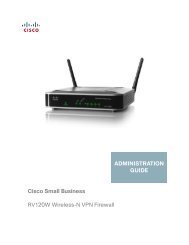Cisco WAP200 Wireless-G Access Point with PoE and ...
Cisco WAP200 Wireless-G Access Point with PoE and ...
Cisco WAP200 Wireless-G Access Point with PoE and ...
You also want an ePaper? Increase the reach of your titles
YUMPU automatically turns print PDFs into web optimized ePapers that Google loves.
<strong>Wireless</strong>-G <strong>Access</strong> <strong>Point</strong> <strong>with</strong> Power Over Ethernet <strong>and</strong> RangeboosterChange these settings as described here <strong>and</strong> click Save Settings to apply your changes, or click CancelChanges to cancel your changes. Help information is available on the right side of the screen.The <strong>Wireless</strong> - <strong>Wireless</strong> Security TabChange the <strong>Access</strong> <strong>Point</strong>’s wireless security settings on this screen.<strong>Wireless</strong> SecuritySelect SSID. Select any of the SSID names configured on the Basic <strong>Wireless</strong> Settings tab.<strong>Wireless</strong> Isolation (between SSID). <strong>Wireless</strong> Isolation prevents eavesdropping in the network. When it isEnabled, wireless frames received on this <strong>Access</strong> <strong>Point</strong> will not be forwarded to other wireless networks (SSIDs).For example, if you have a wireless hotspot, you may want to keep the wireless network (SSID) isolated from yourother wireless networks (SSIDs). This is a global option applying to all SSIDs. The default is Enabled.The following options are specific for each SSID:Security Mode. Select the wireless security mode you want to use, WEP, WPA-Personal, WPA2-Personal,WPA2-Personal Mixed, WPA-Enterprise, WPA2-Enterprise, WPA2-Mixed, or RADIUS. (WPA st<strong>and</strong>s for Wi-FiProtected <strong>Access</strong>, which is a security st<strong>and</strong>ard stronger than WEP encryption <strong>and</strong> forward compatible <strong>with</strong> IEEE802.11i. WEP st<strong>and</strong>s for Wired Equivalent Privacy, Enterprise modes use a RADIUS server for authentication, whileRADIUS st<strong>and</strong>s for Remote Authentication Dial-In User Service.) Refer to the appropriate instructions below afteryou select the Authentication Type <strong>and</strong> SSID Interoperability settings. For detailed instructions on configuringwireless security for the <strong>Access</strong> <strong>Point</strong>, refer to “Appendix B: <strong>Wireless</strong> Security.” To disable wireless securitycompletely, select Disabled. The default is Disabled.Figure 6-4: <strong>Wireless</strong> - <strong>Wireless</strong> Security (Disabled)<strong>Wireless</strong> Isolation (<strong>with</strong>in SSID). When disabled, wireless PCs that are associated to the same network name(SSID), can see <strong>and</strong> transfer files between each other. By enabling this feature, <strong>Wireless</strong> PCs will not be able tosee each other. This feature is very useful when setting up a wireless hotspot location. The default is Disabled.Following section describes the detailed options for each Security Mode.WEPThis security mode is defined in the original IEEE 802.11. This mode is not recommended now due to its weaksecurity protection. Users are urged to migrate to WPA or WPA2.Authentication Type. Choose the 802.11 authentication type as either Open System or Shared Key. The defaultis Open System.Figure 6-5: <strong>Wireless</strong> - <strong>Wireless</strong> Security (WEP)Chapter 6: Configuring the <strong>Wireless</strong>-G <strong>Access</strong> <strong>Point</strong>The <strong>Wireless</strong> - <strong>Wireless</strong> Security Tab19
















